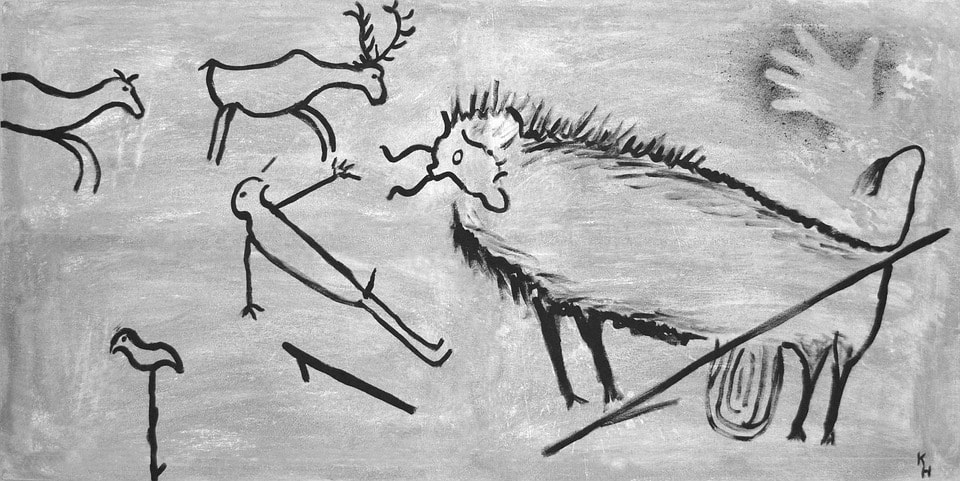|
Unknown painters, who lived in the Palaeolithic era, covered the walls of the Lascaux cave with many images of animals and people. They were made in a very peculiar creative manner, which many painters of our time began to imitate after the opening of the cave. The cave was found in September 1940 by four teenagers from the nearby settlement of Montignac. The total length of the passages of the Lascaux Cave is about 250 meters. There are thousands of drawings, which are divided into 3 categories: animals, people, and symbols. Most of the images are made in red, yellow and black colors from a complex variety of mineral pigments. Some drawings were preserved perfectly, while others are damaged or completely destroyed. About 900 of them are animals shown in motion. Herds of horses, mighty bulls and smooth, graceful feline representatives, bison and even rhinoceroses, all of them froze in an elusive impulse and readiness to attack. However, there are no images of plants or natural landscapes in the cave. Some scholars have suggested that the drawings show an ancient star map with constellations. Others consider the cave a sanctuary or cult place for ancient people. An interesting fact: many prehistoric paintings are preserved so well that it is difficult to believe in their age. This phenomenon can be explained by the presence of transparent crust of deposits of calcite salts. It protects paintings like some kind of varnish. During the study, archaeologists hoped to find traces of burials that would shed light on the life of ancient people but found only more and more drawings, as well as primitive objects of the ancient world. To date, more than 1900 cave paintings have been recorded (according to some data, their number is about 6000). Basically, the figures show various animals in motion. The time when these cave paintings were made is unknown. Scientists believe that this is approximately the 18-15th century BC. At first they were attributed to the Madeleine culture but later began to be associated with the early Solutrean culture. Archaeologists have found some of the oldest tools in the cave. More than 400 stone objects, 28 bone tools, objects similar to jewelry, as well as coloring matters with which the paints were applied. Sometimes Lascaux is called the Sistine Chapel of primitive painting, Prehistoric Versailles and French Altamira. Today, about two thousand prehistoric drawings and engravings are found in the cave. They are divided into three groups according to the theme: people, animals, and symbols. Numerous artifacts were also found: tools made of stone and bone, jewelry, lamps. The brightest “exposition” is situated in the Hall of Bulls: bison, horses, deer and one bear are depicted here. The drawings in the hall have a very large format, some reaching 5m in length. It is clear that to create such monumental "paintings" the ancients built something similar to a scaffolding. Indeed, the remains of an oak tree, most likely the tree from which the scaffolding was made, were found in the cave. Images of deer, sheep, cows, and rhinos can be found there as well. There are many mysterious images in the cave. In particular, one of the prehistoric artists left a drawing of a strange creature with a horn on its forehead resembling a unicorn on the wall of the cave. Among the wall-mounted images, there are also geometric shapes and a color plane divided into equal squares. Finally, there is also a sketch of a man with a bird's head. There are several theories regarding what explains the appearance of such unusual images on the walls of the cave. According to one of the assumptions, the Lascaux Сave was a stone-age temple, and the drawings were illustrations for legends and tales. The discovery and opening of the Lascaux Cave changed its microclimate. The cave slowly collapsed, drawings deteriorated. Given the extreme importance of the cave for research, the authorities decided to close it in 1963. After the real Lascaux Cave was closed, scientists took a lot of photos of the painted vaults of the cave. It was decided to recreate part of the cave in full size. They built a construction where they reproduced the paintings of an ancient cave. It was called Lascaux II. It contains the main sections of the real cave with the opportunity to see some striking painted panels. In July 1983, it was opened to the public. Copies of Lascaux's cave paintings are located in Parc du Thot, near Montignac. The documentary series "Life after people" shows that the copy of Lascaux II will collapse in about 10 years, but the real cave will survive for another thousand years. Most likely, the real Lascaux Cave will never be open to tourists again. To discover more about the world of the Lascaux Cave paintings, visit these links: https://www.donsmaps.com/lascaux.html https://www.lascaux.fr/en/prepare-you... https://time.com/3879943/lascaux-earl... https://www.ancient.eu/Lascaux_Cave/ “Painting is but another word for feeling.” John Constable
0 Comments
Leave a Reply. |
AuthorPhoenix Voyagers Archives
January 2023
Categories |
|




 RSS Feed
RSS Feed




